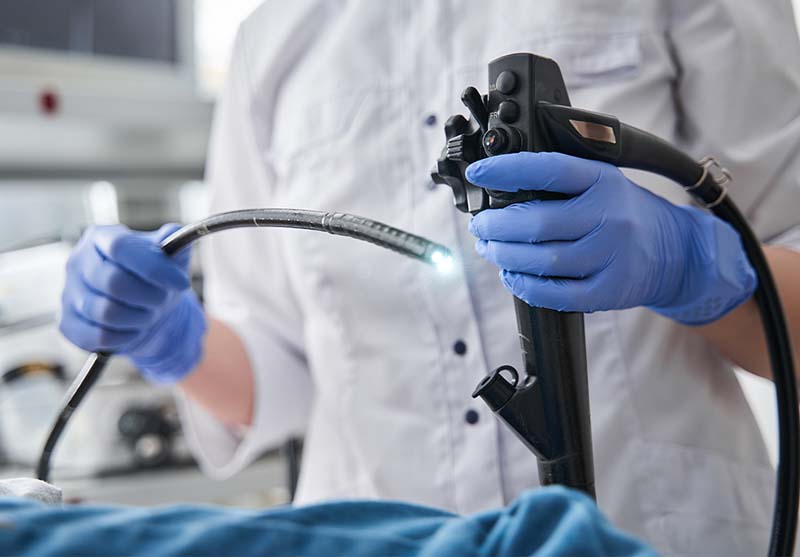What is Gastroscopy?
Gastroscopy, also known as an upper endoscopy or OGD, is a medical procedure used to examine the upper gastrointestinal tract. It involves the use of a thin, flexible tube called an endoscope, which has a tiny light and camera at its tip.

When is Gastroscopy Recommended?
Diagnose Digestive Problems
– Gastroscopy is an important step in diagnosing digestive issues, especially those of the upper gastrointestinal tract. The gastroscopy specialist may recommend the procedure if a patient presents with symptoms such as:- Vomiting
- Heartburn
- Nausea
- Difficulty swallowing
- Unexplained weight loss
- Bloating
- Upper abdominal pain that does not go away
Routine Medical Screening
– If the patient has a history of gastric ulcers or polyps, their risk of stomach cancer may be higher, and the doctor may recommend gastroscopy as a form of preventive screening. The doctor may check for abnormalities such as ulcers, inflammation, polyps, or tumours in the stomach or duodenum. Early detection is key to more effective treatment.Treating Certain Conditions
– Gastroscopy is not just for diagnosis – it can be used for treatment, too. Through a gastroscopy procedure, doctors can perform the following treatments:- Stop bleeding from ulcers
- Remove a foreign body that the patient might have swallowed by accident
- Remove polyps
- Remove small tumours from the stomach
Contact us at:
Patient Care
+65 6518 9838What Can a Gastroscopy Screening Detect?
A gastroscopy provides direct visualisation of the oesophagus, stomach, and duodenum to detect and diagnose various upper gastrointestinal conditions, including:
Inflammation
: Directly visualises any inflammation in the upper GI tract such as gastritis and oesophagitis.Gastric Cancer
: Identifies abnormal growths, ulcers, and suspicious changes in the stomach lining, allowing for biopsies to confirm cancer.Gastroesophageal Reflux Disease (GERD)
: While not always directly visible, gastroscopy can identify signs of oesophageal damage caused by chronic acid reflux.Peptic Ulcers
: Directly visualises open sores in the stomach or duodenum and helps assess severity.Oesophageal Stricture
: Identifies the location and degree of oesophageal narrowing.Helicobacter Pylori Infection
: These bacteria that may reside in the stomach that can cause ulcers and cancer; if found it needs to be eradicated.How to Prepare for a Gastroscopy
To ensure a smooth gastroscopy and accurate results, please follow these preparation guidelines. As with many outpatient procedures, it is important to inform your doctor of your medical history, dress comfortably, bring any required documents, and arrange for someone to take you home afterwards.
Fasting before the procedure
: Prior to the procedure, you will need to fast for 6 hours to ensure an empty stomach. This ensures a clear view for the doctor and reduces the risk of complications.Adjusting medications if necessary
: Let your doctor know about all medication you are taking, especially blood thinners and diabetes medication. They may advise pausing or adjusting certain medications before the procedure.Understanding potential risks
: Although gastroscopy is generally safe, being informed about possible side effects helps you make an informed decision.What to Expect During a Gastroscopy?
Preparation
: Prior to the procedure, you will be asked to fast to ensure an empty stomach. This allows for optimal access and visualization of the stomach.Anaesthesia
: A local anaesthetic is usually applied to your throat to minimise discomfort during the procedure. You may also receive a sedative to help you relax.Insertion of the Endoscope
: The endoscope is gently inserted through your mouth and guided down your throat, oesophagus, and into your stomach and down into the duodenum (the start of the small intestine). You may be asked to swallow to help pass the scope pass more easily.Examination
: The camera at the end of the endoscope sends real-time images to a monitor, allowing the doctor to examine the lining of your upper digestive tract. To get a clearer view, a small amount of air may be gently introduced into your stomach.Biopsy and Treatment
: If any abnormalities or issues are detected, the doctor may take tissue samples (biopsies) for further testing. They may also perform other procedures such as removing polyps, dilating strictures, treating bleeding ulcers, or placing stents to open a narrowed area.Removal of the Endoscope
: Once the examination is complete, the endoscope will be carefully removed.Recovery
: After the procedure, you will be monitored until the effects of the anaesthesia wear off. It is essential to have a friend or family member accompany you in leaving the clinic, as you may still feel drowsy.A gastroscopy is considered a very safe and useful procedure. It typically takes just around 10-20 minutes, followed by a short period of observation before you are discharged.
What are the Risks of Gastroscopy?
Gastroscopy is generally safe, but like all medical procedures, it carries some risks.
Sore Throat
– Temporary discomfort may last a day or two after the procedure.Bleeding
– May occur if a biopsy is taken or polyps are removed.Reaction to Sedation
– Sedatives may cause some side effects like nausea and dizziness.Perforation
– A rare but serious tear in the oesophagus, stomach, or duodenum.If you experience persistent pain, difficulty swallowing, fever, or unusual bleeding after the procedure, contact your doctor promptly.
Frequently Asked Questions
Our doctor is experienced in performing gastroscopies for diagnostic and treatment purposes. Make a prompt appointment at 6518 9838 or WhatsApp us today.
01
Evidence Based Treatment
02
Competence & Experience
03
Excellent Patient Care